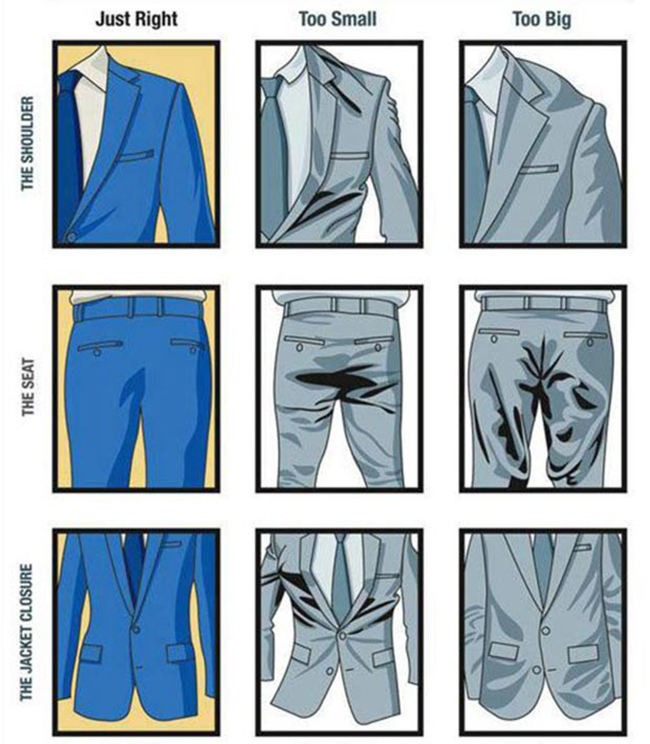
Tips for Selecting a Suit
There are many important decisions to make when selecting a suit: style/cut, fabric, color, and having the suit fitted properly.
Nowadays there are many suit styles to choose from but all of them are based off of three traditional styles: America, European/Italian and English. Although some of the elements of each of these tradition styles have crossed over to other styles, they are still considered to be a useful guide in determining which cut or style should work best for your body type.
American:
American-style suits are good for people with huskier or larger body types because the American suit was designed to fit the larger frames of Americans as opposed to Europeans. It is common to find American suits that feature three buttons and a single breast although jackets with two buttons are quite popular as well. It’s easy to find double-breasted American suits too.
European/Italian:
European-style suits, which might also be called Continental or Italian suits, typically are cut close to the body and feature two buttons and a single breast. These suits tend to make slender men look very good, but, unfortunately, they do not flatter larger men. These suits are fit to a man’s form, and they can make a man whose body type isn’t slender look like a small boy.
English:
English-style suits, which are also referred to as British-style suits, look very flattering on people of average or athletic body types. English suits are somewhat modeled on military uniforms, which can give the wearer a sharp, authoritative look. Military uniforms tend to follow the lines of the body, and English suits do the same. Tall men also tend to look good in English-style suits.
Once you’ve decided which cut you like best, you then need to think about fabric, color and fit.
Fabric:
Choosing which fabric the suit is made from is very important. Certain fabrics, like cotton, wool, silk, and linen, breathe better than other fabrics. Additionally, these fabrics can help keep the wearer warm during the winter and cool during the summer.
Luxurious fabrics, like silk and cashmere, will feel great on the skin but will also be much more expensive than common materials like wool and cotton.
If you are only going buy one suit, it should wool. Look for suits made of 100% “worsted” wool. The worsting process involves selecting long wool fibers and twisting them into tight and resilient yarns. Worsted wool suits are durable, hard-wearing, and usually fine for wear in all seasons.
Color:
For a first suit, it is a good idea to choose a dark, solid color such as charcoal gray, black, or navy blue. For men who purchase many beyond the basic solid colors, subtle patterns such as pinstripes or herringbone may be considered. Try to choose colors and patterns that will stand the test of time and will be appropriate for the settings in which the suit will be worn.
Proper Fit:
When shopping for a suit, the salesperson to take all measurements: neck, shoulders, sleeves, chest, waist, and inseam. Have them measure first, before you begin looking at suits.
If there is any part of the suit that doesn’t fit correctly, it should be altered by the shop. In some stores, alterations are free, and in some you will pay a fee. Again, it is good to be working with a salesperson that has your best interests in mind when it comes to fitting.
Here are few general rules…
The Jacket
- The jacket should lie smoothly over your shoulders and across your back, and should look proportional to your physique. The length of the jacket should cover up your entire backside (your butt). The back of the jacket should end where your butt meets your leg.
- Jacket sleeves should end at the point where your hands meet your wrists and show 1/2 inch of your shirt cuff. Higher armholes may help your suit to drape better on your body, but they should never feel tight or binding. Make sure that you have free movement of your arms. As a test, bring your arms straight out in front of you.
- The collar should hug the back of the neck without buckling or pulling. 1/2 inch of your shirt collar should show from under the suit’s collar.
- Shoulder pads, if you have them, should help the suit to hang properly and help you achieve more of a “V” shape. For guys with narrow shoulders, pads might help you look more masculine, but they should never be too bulky or obvious, nor should they be so wide as to diminish the appearance of the head. The shoulders of a jacket should frame the head for a balanced presentation.
- Lapels should lie flat to your chest, and should never bunch up or buckle.
- Vents are in the flap of cloth below the waist at the back of the jacket that covers your backside (your butt). You can have one, two, or no vents depending on your body type. If you have a large backside, two vents are advisable; if you have a very flat backside, you can opt for no vents. The idea is to not have the back of the jacket stretching across your butt.
The Pants
- The waistline should be comfortable; make sure that you can stick two fingers into the waist while you’re wearing them. Suit pants tend to be worn a bit higher than jeans, which are usually worn on the hip. Usually the waist of suit pants falls at or just below the navel.
- Cuffs help the pants provide a little weight at the bottom and help the pants to hang correctly. Stick to a maximum 1.5″ cuff, unless you are short, in which case you might want to try a 3/4″ cuff, or avoid them altogether, as they tend to make the legs appear shorter.
Below are some visual examples that show proper fit verses improper fit.


Find the Right Retailer
Locally there are four fabulous shops that offer quality and service:
Parsows
120 Regency Parkway, Omaha, NE 68114
Rossi Clothiers
11032 Elm St., Omaha, NE 68144
Lindley Clothiers
707 N. 132nd St. Omaha, NE 68154
Jerry Ryan
7806 Dodge St Omaha, NE 68114
Care and Cleaning:
- Rotate your suits. Wearing the same suit over and over will cause it to show wear after a while.
- Use a steam cleaner to remove wrinkles before wearing. Set the steam to the lowest heat setting. This way you always appear freshly pressed without the added costs.
- Brush off any dirt or food particles that may be clinging to the suit after you wear it. Start by going against the grain of the cloth and use short, quick strokes. Finish with a second pass that goes with the nap.
- Allow your suit to hang for a day or two on a good wood hanger after wearing it. This allows the material to recover and drape out most wrinkles between uses. Make sure all of the pockets are empty to avoid creating creases, or odd shapes in your suit.
- Cover it up. Use a cloth cover which allows air to still circulate through the suit even when its being stored.
- Suits should only be dry cleaned when they need it and it is important to choose the proper dry cleaner.
Some harsh dry cleaning chemicals can be break down the fabric, so choosing a quality dry cleaner like Omaha Lace Cleaners is a must. Omaha Lace Cleaners utilizes gentle yet effective solutions like GreenEarth and System K4, two of the newest and most effective eco-friendly solvents in the dry cleaning industry.










